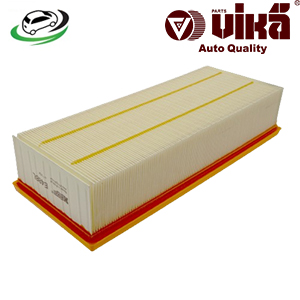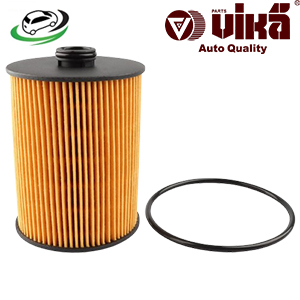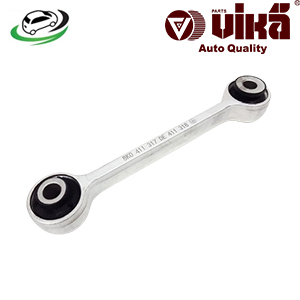-16%
Get Front Stabilizer Link Audi A4/B8/A5/A6/A7/Q5 8K0411317D
Stabilizer links, also known as sway bar links or anti-roll bar links, are critical components in a vehicle’s suspension system. They connect the sway bar (or stabilizer bar) to the vehicle’s suspension. Their primary role is to reduce body roll during cornering or when driving over uneven surfaces, thereby enhancing the vehicle’s stability and handling.
The Role of the Sway Bar
Before delving into the specifics of stabilizer links, it’s important to understand the sway bar itself. The sway bar is a torsion spring that resists the roll of the vehicle. It is usually a metal bar that spans the width of the vehicle and connects the left and right sides of the suspension. When the vehicle turns, the sway bar twists and provides a counteracting force to the body roll.
Components of Stabilizer Links
- Rod/Bar: The main part of the stabilizer link is typically a metal rod or bar. It can vary in length and thickness depending on the vehicle’s design.
- Bushings: These are usually made of rubber or polyurethane and provide cushioning. They absorb vibrations and reduce noise.
- Ball Joints: Some stabilizer links have ball joints at their ends. These joints allow for flexibility and range of motion, ensuring that the stabilizer link can move with the suspension without binding.
Types of Stabilizer Links
- Fixed Stabilizer Links: These are simple, non-adjustable links. They are solid in construction and provide a fixed connection between the sway bar and the suspension.
- Adjustable Stabilizer Links: These links can be lengthened or shortened. They are often used in performance or custom applications where suspension geometry needs to be fine-tuned.
- Disconnectable Stabilizer Links: Found in some off-road vehicles, these links can be disconnected to allow for greater wheel articulation when off-roading.
How Stabilizer Links Work
When a vehicle takes a turn, the inertia causes the body to roll towards the outside of the turn. This roll compresses the suspension on the outside of the turn and extends it on the inside. The sway bar, connected via the stabilizer links, twists to resist this motion. The stabilizer links transfer the force from the sway bar to the suspension components, effectively reducing the body roll.
Benefits of Stabilizer Links
1. Improved Handling
Stabilizer links contribute significantly to a vehicle’s handling by reducing body roll during cornering. When a vehicle turns, the outer side tends to lift while the inner side dips. Stabilizer links help the sway bar counteract this motion, ensuring that the vehicle remains level and stable through the turn. This results in more precise steering and better overall control.
2. Increased Stability
By minimizing body roll, stabilizer links enhance the vehicle’s stability, especially during sharp turns or sudden maneuvers. This stability is crucial for maintaining traction and preventing rollovers, particularly in high-speed driving conditions or when navigating curves.
3. Enhanced Safety
With improved handling and stability, stabilizer links contribute to overall vehicle safety. They ensure that the tires maintain better contact with the road, which is vital for effective braking and steering. This can be particularly important in emergency situations where quick and controlled responses are necessary.
4. Reduced Wear and Tear
Stabilizer links help distribute forces more evenly across the vehicle’s suspension system, reducing the stress on individual components. This can lead to less wear and tear on suspension parts, potentially lowering maintenance costs and extending the lifespan of the vehicle’s suspension system.
5. Better Ride Comfort
By reducing excessive body roll and stabilizing the vehicle, stabilizer links contribute to a smoother and more comfortable ride. Passengers are less likely to experience the uncomfortable swaying and jolting that can occur when a vehicle’s suspension is not properly supported.
6. Enhanced Performance in Adverse Conditions
In adverse driving conditions, such as wet or uneven roads, stabilizer links help maintain vehicle stability. This is crucial for maintaining control and avoiding skidding or slipping. The additional stability provided by the links can make driving in these conditions safer and more manageable.
7. Improved Tire Contact and Wear
Stabilizer links help ensure that the tires maintain consistent contact with the road surface. This not only improves handling and braking performance but also promotes even tire wear. Uneven tire wear can lead to reduced traction and the need for premature tire replacement, so stabilizer links indirectly contribute to prolonging tire life.
8. Enhanced Performance in Towing and Hauling
For vehicles used for towing or hauling heavy loads, stabilizer links are particularly beneficial. They help manage the additional forces exerted on the suspension system, ensuring that the vehicle remains stable and controllable even when carrying heavy weights.
9. Optimized Suspension Geometry
Adjustable stabilizer links, in particular, allow for fine-tuning of the suspension geometry. This can be beneficial for performance enthusiasts who wish to customize their vehicle’s handling characteristics or for those who have modified their suspension and need to adjust the stabilizer links to match.
10. Prevention of Suspension Damage
By mitigating excessive body roll and distributing forces evenly, stabilizer links help prevent potential damage to other suspension components. This can save on costly repairs and downtime associated with suspension failures.
Symptoms of Worn or Faulty Stabilizer Links
1. Clunking or Rattling Noises
One of the most noticeable symptoms of worn or faulty stabilizer links is a clunking or rattling noise. This noise often occurs when driving over bumps, potholes, or uneven surfaces, as well as when making turns. The noise is caused by the excessive play in the worn stabilizer links, which allows them to move and hit other suspension components.
2. Poor Handling and Increased Body Roll
Worn stabilizer links can lead to a significant decrease in handling performance. You may notice increased body roll when cornering, making the vehicle feel less stable and more difficult to control. This is because the stabilizer links are no longer able to effectively transfer the forces from the sway bar to the suspension, reducing its ability to counteract body roll.
3. Uneven Tire Wear
Faulty stabilizer links can cause improper alignment of the suspension, leading to uneven tire wear. If you notice that your tires are wearing out more quickly on one side than the other, it could be a sign that the stabilizer links are not functioning correctly and are causing the suspension to be misaligned.
4. Excessive Swaying
A vehicle with worn stabilizer links may exhibit excessive swaying, especially when making turns or driving on windy roads. This swaying occurs because the stabilizer links are unable to provide the necessary resistance to body roll, making the vehicle feel less stable and more prone to excessive movement.
5. Steering Issues
Faulty stabilizer links can affect the steering response of the vehicle. You might experience a looser or less responsive steering feel, especially when taking corners. This is because the stabilizer links are not providing the proper support to the sway bar, leading to reduced stability and control.
6. Visible Wear or Damage
A visual inspection of the stabilizer links can sometimes reveal obvious signs of wear or damage. Look for cracked or split bushings, corroded or bent rods, or loose connections. Any visible damage to the stabilizer links indicates that they are no longer functioning properly and need to be replaced.
7. Vehicle Leaning to One Side
If the stabilizer links are significantly worn or broken, the vehicle may lean to one side. This occurs because the stabilizer links are not distributing the forces evenly across the suspension, causing one side of the vehicle to dip lower than the other.
8. Difficulty Maintaining Straight Line
Worn stabilizer links can cause the vehicle to wander or drift, making it challenging to maintain a straight line while driving. This is due to the lack of stability provided by the compromised stabilizer links, affecting the overall handling and alignment of the vehicle.
9. Increased Noise During Cornering
In addition to clunking noises over bumps, you might also hear increased noise specifically when cornering. This noise can be due to the increased stress on the stabilizer links during turns, which are not being properly supported due to wear or damage.
Maintenance and Replacement
Regular inspection of stabilizer links is crucial for maintaining vehicle safety and performance. Here are steps involved in maintaining or replacing stabilizer links:
- Inspection: Check for any signs of wear, such as damaged bushings or loose connections.
- Lubrication: Some stabilizer links may require periodic lubrication, especially those with ball joints.
- Replacement: If a stabilizer link is found to be worn or damaged, it should be replaced. This typically involves lifting the vehicle, removing the old link, and installing a new one. It’s advisable to replace stabilizer links in pairs to maintain balanced handling.
Follow us on Facebook for more parts.



